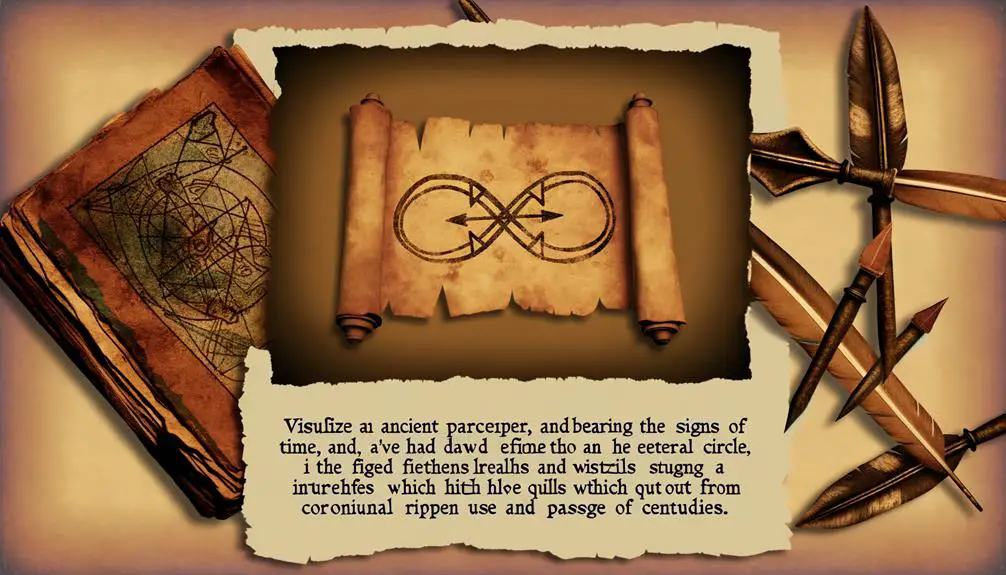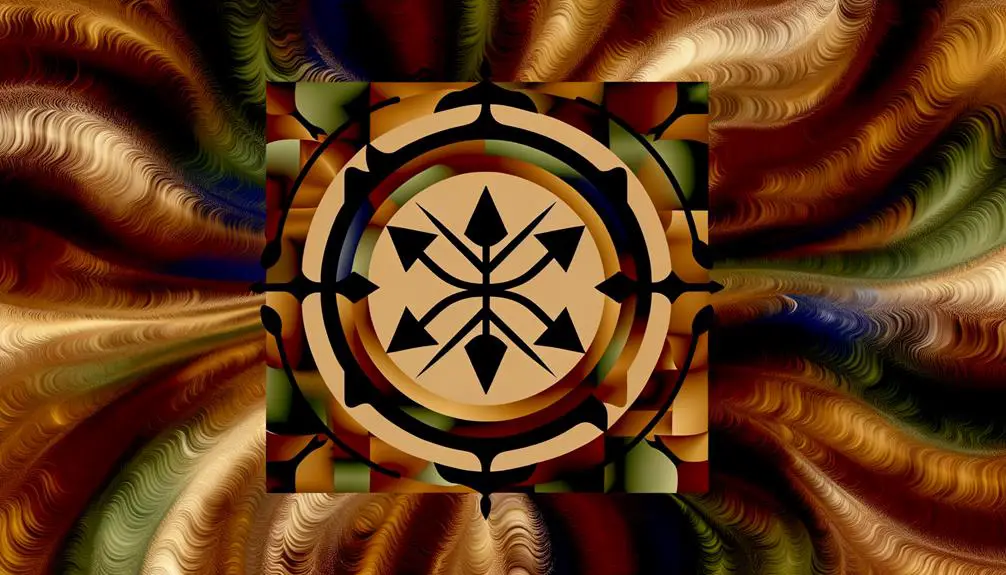What Is the Meaning of the Two Arrows Circle Symbol?
The symbol of two arrows forming a circle has profound historical significance, evoking concepts of unity, cyclical time, and interconnectedness. In Native American culture, it represents the harmony between the physical and spiritual worlds.
Ancient Celtic traditions associate it with the eternal flow of time, while Greeks use it to illustrate perpetual motion and unity. This motif also resonates in Asian cultures, symbolizing the endless interplay of opposites, akin to the yin-yang principle.
Modern interpretations often highlight themes of environmental sustainability and communal unity. For a deeper understanding of its cultural depth and contemporary relevance, continue exploring.

Key Takeaways
- Represents the cyclical nature of life as seen in Native American and ancient Celtic traditions.
- Symbolizes perpetual motion and unity, influenced by Greek culture.
- Depicts the endless interplay of opposing forces, akin to the yin-yang principle in Asian traditions.
- Modern interpretations emphasize environmental sustainability and interconnectedness.
- In art, it underscores continuity, unity, and the cyclical nature of existence.
Historical Origins

The symbol of arrows in a circle has its historical origins rooted in various ancient cultures, each attributing distinct meanings and purposes to its use.
In early Native American iconography, this symbol often represented the cyclical nature of life, emphasizing harmony and balance.
Similarly, in ancient Celtic traditions, circular arrows denoted the eternal flow of time and natural cycles.
The Greeks, particularly in Pythagorean thought, used circular arrows to illustrate concepts of perpetual motion and unity.
Additionally, Asian cultures, including ancient Chinese philosophy, adopted this motif to symbolize the endless interplay of opposing forces, akin to the yin-yang principle.
Therefore, the convergence of these interpretations underscores the universal appeal and enduring legacy of the arrows in a circle symbol.
Cultural Significance
Throughout history, the symbol of arrows arranged in a circle has carried profound cultural significance, representing unity, cycles, and directionality in various ancient civilizations.
These ancient insights continue to inform modern interpretations, where the symbol is often seen in contexts ranging from corporate logos to spiritual practices.
Understanding its cultural resonance allows us to appreciate the enduring legacy and contemporary relevance of this powerful emblem.
Ancient Symbolism Insights
In various ancient cultures, the symbol of arrows arranged in a circle often represented cyclical time, unity, and the interconnectedness of life and nature.
This emblematic design was prevalent among early civilizations such as the Celts, Native Americans, and indigenous tribes of the Pacific Islands. For the Celts, it signified eternal cycles, akin to the Wheel of the Year in their calendar.
Native American tribes viewed the symbol as embodying the harmony between the physical and spiritual domains. Similarly, Pacific Island cultures used it to depict the cyclical nature of life and death, as well as the interdependence within their communities.
These interpretations underscore the profound respect ancient societies held for the natural world's rhythms and their place within it.
Modern Interpretations Today
Embracing both historical context and contemporary relevance, modern interpretations of the arrows in a circle symbol often highlight themes of environmental sustainability, communal unity, and the ongoing cycles of renewal. This symbol has been adopted by various movements to represent the interconnectedness of human actions and natural processes. In today's cultural landscape, it serves as a poignant reminder of our responsibility to maintain ecological balance and foster collective harmony.
| Theme | Symbolic Meaning | Emotional Impact |
|---|---|---|
| Environmental Sustainability | Interconnected Ecosystems | Responsibility |
| Communal Unity | Shared Goals and Cooperation | Solidarity |
| Cycles of Renewal | Continuous Growth | Hope and Rejuvenation |
Thus, the symbol continues to inspire and evoke a sense of duty and optimism in contemporary society.
Symbolism in Art

Symbolism in art often employs arrows in a circle as a powerful motif to convey themes of continuity, unity, and cyclical nature.
Historically, this symbol has been used across various cultures and artistic movements to represent the unending flow of time and the interconnectedness of life.
In Renaissance art, the circular arrow motif was frequently integrated into compositions to signify eternal life or divine perfection.
In the 20th century, this symbolism was revisited by artists influenced by Eastern philosophies, emphasizing the cyclical concept of existence.
Interpretive analysis reveals that the symbol's recurring use underscores a universal human fascination with the perpetual cycles governing our existence, from nature's seasons to human life stages, thereby fostering a deeper understanding of our place within the cosmos.
Modern Uses
Today, the arrows in a circle symbol continue to be employed in various modern contexts, ranging from corporate logos to environmental activism, where it often signifies concepts such as sustainability and the circular economy. This symbol has evolved to represent a commitment to resource efficiency and ecological responsibility.
Specifically, its modern uses include:
- Corporate Branding: Many companies incorporate the symbol in their logos to highlight their dedication to sustainable practices.
- Recycling Initiatives: The symbol is widely recognized in recycling campaigns, indicating recyclable materials or products.
- Educational Programs: Institutions use the symbol in curricula and awareness programs to promote environmental consciousness.
These applications underscore the symbol's enduring relevance and its ability to convey complex, important messages succinctly.
Psychological Impact

From a psychological perspective, the arrows in a circle symbol often evoke a sense of continuity and interconnectedness, resonating deeply with individuals' innate desire for harmony and balance. Historically, circular motifs have represented cycles of life, nature, and the cosmos, reinforcing the idea that life is a perpetual journey.
The arrows, signifying direction and purpose, integrate this timeless concept with modern notions of progress and evolution. This synthesis can foster a reassuring sense of order and predictability, which is psychologically comforting.
The symbol's duality suggests a balanced dynamic between opposing forces, echoing the principles of equilibrium found in Jungian psychology and Eastern philosophies. It serves as a powerful visual metaphor for mental and emotional stability.
Personal Interpretations
The arrows in a circle symbol often hold diverse meanings based on individual perspectives, reflecting unique personal experiences and beliefs.
Historically, such symbols have been imbued with various cultural significances, yet their contemporary interpretations can vary widely among individuals.
This variance underscores the symbolic personal significance and individual interpretations that people attribute to the symbol, shaping its relevance in personal contexts.
Symbolic Personal Significance
Interpreting the arrows in a circle symbol often varies widely, as individuals may ascribe personal meaning based on their unique experiences and cultural backgrounds. This emblem's fluidity allows for diverse symbolic personal significance. Historically, symbols like these have been integrated into various cultural narratives, offering a rich tapestry of interpretive possibilities.
- Life Cycles: Many see the arrows in a circle as representing the cyclical nature of life, emphasizing renewal and continuous progress.
- Balance and Harmony: Others interpret the symbol as a representation of balance and harmony, reflecting the interconnectedness of opposing forces.
- Personal Growth: For some, the symbol signifies personal growth and the journey towards self-improvement and enlightenment.
Such personal interpretations reflect the multifaceted nature of symbolic language.
Individual Interpretations
As individuals reflect on the arrows in a circle symbol, their interpretations often draw from personal experiences and cultural narratives, imbuing the emblem with unique meanings ranging from the cyclical nature of existence to the pursuit of personal growth. Historically, circles have symbolized eternity and unity, while arrows have signified direction and intent.
When combined, these elements may resonate differently based on one's background. For some, the symbol represents life's perpetual cycles and the inevitability of change. Others may view it as a reminder of their journey towards self-improvement and resilience.
This divergence in interpretation underscores the symbol's versatility, allowing it to serve as a meaningful representation tailored to individual life experiences and aspirations.
Conclusion
To sum up, the symbol of two arrows in a circle has evolved through historical origins, cultural significance, and artistic symbolism, ultimately finding diverse applications in modern contexts.
This emblem, rich with interpretive layers, continues to capture the imagination, reflecting cycles, unity, and continuity. Modern uses span from corporate logos to psychological frameworks, illustrating its enduring relevance.
As the saying goes, 'a picture is worth a thousand words,' underscoring the profound impact this symbol has across various domains.





